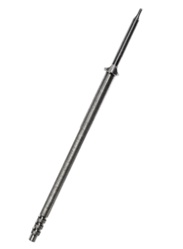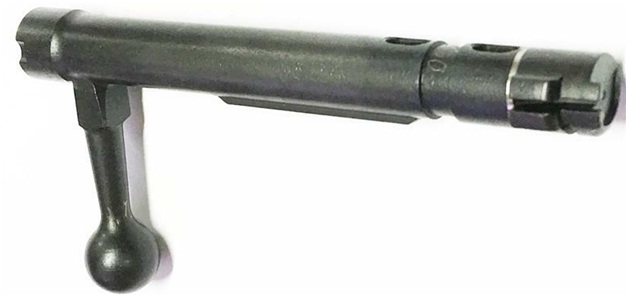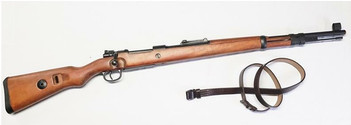Gewehr 98 to Mauser 98K: Lasting Mauser Ingenuity
Mar 3rd 2021
You may hear the name “Mauser” being thrown around with a very cavalier attitude, as though Mauser can be succinctly categorized or described. It can’t; and what’s more, though many firearms are simply referred to as “Mausers” because they were produced by Mauser or are variants of originals, there is no one “single” Mauser that should be so called.
Part of this ambiguity may stem from the fact that Mauser itself is a long standing German arms manufacturer that has produced a variety of small arms ever since way back in the 1870s. While Mauser may be commendable for its long history of successful production, it is not the length of their tenure alone that has brought the company so much respect and admiration.
Many other arms manufacturers have long standing histories as well, but few if any of them can match the influence that Mauser has had on modern, repeating arms. It can be said with only a grain of embellishment that Mauser, over the course of its history, has revolutionized arms manufacturing.
At the time that Mauser started producing firearms, many small arms around the world were cumbersome breech loaders or single shot platforms. Many of these still fired black powder cartridges. In fact, in the late 19th century, although muzzleloaders were falling out of military use and being replaced with breech-loading repeaters, they were still common enough around the world that Mauser’s ingenuity shines all the more brightly.
If there was one platform that defined the Mauser name, it was likely the Gewehr 98, also known as the M98 or the MauserM98.
Gewehr 98 (A.K.A M98 or Mauser M98)
It is the Mauser Gewehr 98 rifle that perhaps more than any other Mauser platform defines the name. It saw widespread military service throughout the first half of the 20th century, as it was in service from 1898 until 1935, at which point it was replaced by the Mauser K98k which will be investigated in more detail directly following this section.
Notably, you may recall that a significant global conflict occurred during the tenure of this rifle; that is, the most significant political and military engagement that had ever befallen the earth up to that point - the First World War. The Gewehr M98 was widely carried by German forces as an infantry weapon widely throughout World War 1, where it gained the respect of the German infantry and the respect, if not fear, of the Allies.
The Gewehr M98 is a full stocked rifle with iron sights, chambered in the hard-hitting 7.92x57mm Mauser cartridge; it was fed from a stripper clip and operated via the infamous Mauser Gewehr M98 bolt action. This action, which is often simply referred to as a “Mauser Action” is one of the most successful firearm actions ever designed. It was so strong and so reliable that it can effectively be said to have set the framework for nearly all over bolt-action rifles that followed.
The entire platform, assembled and operable, is a commendable and formidable weapon in its own right, but it’s truly the action that has made this rifle so enduring. It’s been called “the greatest rifle ever made” more than once, by more than one source, and the reason for this centers around the action. Paul Mauser would be proud if he could see today what kind of influence this action has had on ensuing firearms development.
It wasn’t the first bolt action rifle ever developed, although that honor does lie with another German firearms producer, Johann Nikolaus von Dreyse. The fact that the Mauser action eclipsed so many precedent models is evidence enough of its impressive reliability and safety.
The action of the Mauser Gewehr 98 was noteworthy for several features that came together to make it one of the most effective designs ever produced. The bolt itself has three locking lugs which make the action unbelievably strong. Lugs, which hold the action closed during firing but must be disengaged in order to extract a fired shell and load a new one, are under immense stresses and are a point of failure for breech-loading firearms.

The Mauser M98 had two locking lugs at the front of the bolt assembly that engaged to keep the action locked tight during firing, with a third locking lug at the rear of the assembly that served as a backup in case of a failure.
Another noteworthy feature of this Mauser action is the firing pin mechanism that cocks as soon as the bolt is opened. This mechanism protrudes slightly from the rear of the bolt group and falls forward when fired. In many modern rifles, the firing pin is entirely internal and it cannot be seen if the rifle is cocked or the firing pin has fallen forward when the action is closed.
This firing pin assembly is also commendable because Mauser decreased the distance the firing pin needed to travel from previous models. This decreased lock time commensurately and enabled a faster rate of fire.
On the subject of rate of fire, the Mauser was able to produce not only a very high rate of fire but also a very smooth action. The action also features a controlled-feed mechanism that contains a large, reliable claw extractor that engages the rim of the cartridge as soon as the round leaves the clip. Regardless of the positioning of the rifle or whether or not the cartridge has been fired, the extractor mechanism will result in positive extraction before chambering another round; this helps to prevent jams and hangups that are deadly in the course of combat.
The Mauser M98 action had a relatively short throw with a straight bolt handle that could be rapidly cycled. Due to some of the innovations mentioned above, the action was reliable, strong and safe. Others who have handled Mausers with the M98 action make the recurring comment that the action of the bolt is remarkably fluid. Even today, in some Mausers that have survived for nearly 100 years, the action remains impressively smooth and secure. Truly, Mauser actions are some of the smoothest cycling actions that have ever been produced. Additionally, some of the features mentioned above, such as the extraction mechanism and the third lug have been built into rifle actions that have followed.
These features came together to result in Mauser military rifles that offered smooth cycling, high rates of fire, and reliable operation that served the German Army admirably through both world wars. This rifle, however, did not see much, if any, German service through World War II. That honor belongs to the 98K rifle.
The Karabiner 98K (A.K.A. K98k)
The Karabiner K98k, also known as the Mauser Kar 98k, is a variant of the Mauser Gewehr M98 that saw service throughout the Second World War in the hands of soldiers fighting for Nazi Germany.
This rifle model made the most of the successes of a long line of Mauser technology but featured a few consequential improvements over the original Gewehr 98. It’s also chambered in the same round as the Gewehr 98, the 7.92x57mm Mauser cartridge and features a very similar action, but it is shorter, lighter and more maneuverable, hence the name. Karabiner, unsurprisingly, is German for carbine, our word for a short rifle. As for the “k” at the end of 98k, it stands for the German word kurz, which means short. Think “cut” or “curtailed.” This is a “cut down” version of the original Gewehr 98.
Besides the fact that the Mauser 98k was shortened and lightened, there was a significant change made to the bolt handle; it was curved, a feature that is common in many modern bolt-action rifles. In fact, almost all modern rifles have curved bolt handles, which is a feature for which the Mauser 98k helped to pave the way.
You may also have noticed that straight bolt handles were pretty much a staple on early versions of bolt-action rifles. It was anomalous at the time to produce a bolt with a curved handle. You can still see straight bolt handles, even today, on many models of dated military rifles, though they are rare if not absent in contemporary production.
But how could a curved bolt handle have such a consequential impact? Something so small, in theory, should not revolutionize the operation of a repeating arm, especially when most of the other components of the action remained static. However, the curved bolt handle was a game changer.

For one thing, the curved bolt handle lies alongside the frame of the rifle when the action is closed. That means there is less protruding off the body of the rifle, which isn’t really a big deal at the range, but is an annoyance when traveling overland, through brush, or when carrying other gear. A straight bolt handle sticks out and gets in the way. You can see in the image above the straight-handled style of bolt that Mauser M98 rifles were made with.
Speaking of getting in the way, the curved bolt handle made it practical to mount optics directly over the action on the receiver for the proper eye relief. As you can imagine, this significantly affected the efficacy of German sniper rifles built around the action or using the platform.
Additionally, a curved bolt handle is no less easy to access and operate than a straight handle; if anything, the bolt is easier to cycle more rapidly under pressure, enabling an even higher rate of fire from the Gewehr M98, which already cycled smoothly and quickly.
Some of these final developments to the Mauser 98k, which included changes to the iron sights to reduce glare under unfavorable conditions, results in it becoming one of the most successful ever carried by the German Army. One thing is certain. The Mauser 98k was the defining infantry rifle of the German Wehrmacht.
Why Everyone Loves Them
Both of these rifles, the Mauser Gewehr M98 and the Mauser 98k, are extremely popular platforms among collectors and other enthusiasts. Here are some of the basic draws of these firearms.
●Historical Significance
Obviously, the biggest draw of these firearms has been their historical significance. Collectors of militaria and historical firearms are often enthralled by the prospect of owning one of these Mauser rifles. Additionally, those interested in German military history see the Mauser 98k and the original 98 as icons, in the same way that Americans view an M1 Garand or the English see the Lee-Enfield.
●Contribution to Firearms Engineering
Other collectors, even those whose interests are mechanical and not military, can appreciate the striking impact that Mauser has had on the development of firearms over the last 150 years or so. A mauser action, even today, is one of the smoothest ever designed; they heavily influenced the design of bolt actions that follow, and the legacy is apparent even to this day.
●Recreational Shooting
As the action is so reliable and the platform itself has had such a wide influence, Mausers of many types are still very popular rifles today, both for recreational shooting and for competition, at least where practical.
For this reason, there are still many outfitters selling variants that are effectively identical to the original Mausers.
●Sporting Purposes
Some shooters no doubt will be drawn to these Mausers for use as sporting rifles. Where legal, the 7.92x57mm Mauser rifle round is a very effective hunting cartridge similar in performance to the 30-.06, which has taken scores of American game and continues to do so today.
Of course, Mauser still produces rifles to this day, which are popular around the world with hunters from all walks of life.
We Have What You Need Right Here!
Coming across parts and accessories for an original Mauser might seem like a chore if you don’t know where to look, but lucky for you, you’re already reading an article right on the website on the finest source there is.
Here at Sarco, Inc., we specialize in providing rifle parts, accessories and attachments for popular and hard-to-find historical firearms, along with the firearms themselves and even non-firing replica firearms.
Whatever you’re looking for, don’t let it go by you. Even if you can’t find it on our site, we’ll help you get what you need. Just call us at 610-250-3960 and ask!

